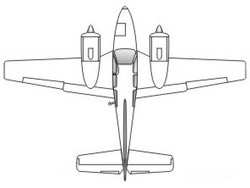Told The Board He Intended To Lessen The Force Of Impact
The pilot of a Beech B55 Baron who impacted a garage during a
forced landing attempt did so on purpose in an effort to make the
crash survivable. His instincts apparently were good, as he and his
three passengers survived the accident, but all were seriously
injured.

NTSB Identification: ERA12FA074
14 CFR Part 91: General Aviation
Accident occurred Thursday, November 17, 2011 in Ulysses, PA
Aircraft: BEECH 95-C55, registration: N54552
Injuries: 4 Serious.
This is preliminary information, subject to change, and may
contain errors. Any errors in this report will be corrected when
the final report has been completed.
On November 17, 2011, about 1619 eastern standard time, a
twin-engine Hawker Beechcraft Corporation B55 Baron, N54552,
impacted a garage during a forced landing following a total loss of
engine power near Ulysses, Pennsylvania. The airplane was
substantially damaged during the impact sequence and consumed by a
post crash fire. The certificated airline transport pilot and three
passengers were seriously injured. The airplane was registered to a
corporation and operated under the provisions of 14 Code of Federal
Regulations Part 91 as a business flight. Visual meteorological
conditions prevailed, and an instrument flight rules flight plan
was filed for the flight that originated from New Castle Airport
(ILG), Wilmington, Delaware, around 1500, with the intended
destination of Buffalo Airfield (9G0), Buffalo, New York.
According to the pilot, the airplane departed ILG after it was
serviced with 23 gallons of fuel. The airplane was in cruise flight
at 8,000 feet mean sea level (msl), when, due to turbulence and
rime icing, the pilot requested a descent to 6,000 feet msl. The
pilot then switched the fuel selector positions from auxiliary fuel
tank to the main tank on both the left and right selectors. Soon
after, the left engine began to surge. As the pilot attempted to
restore the left engine to full power, the right engine surged. As
the pilot performed remedial actions to restore power to the right
engine, the left engine stopped producing power. Within seconds,
the right engine stopped producing power.

The airplane descended through clouds over mountainous terrain,
and descended beneath the clouds only a few hundred feet above the
ground. The pilot's first two choices for the forced landing were
unavailable, so he "stalled the airplane into the garage" to lessen
the impact forces.
The airplane collided with and came to rest inside a 50-foot by
75-foot garage and attached workroom. After the impact a
significant post crash fire ensued, but the occupants were able to
egress the airplane and the garage without assistance.
The garage contained four cars as well as several machines,
tools, thinners, and other solvents. The fire was fueled by
aviation fuel, gasoline, and a coal pile located behind the
structure. After the fire, only an outline of the garage structure
remained and few identifiable pieces of the airplane were
discovered in the debris.
The airplane components identified were the outboard sections of
the left and right wings, the left and right engines, left and
right landing gear supports, four seat frames, main landing gear
supports, and throttle quadrant cabling.
 Aero-News: Quote of the Day (12.07.25)
Aero-News: Quote of the Day (12.07.25) ANN's Daily Aero-Linx (12.07.25)
ANN's Daily Aero-Linx (12.07.25) NTSB Final Report: Lafferty Jack Sea Rey
NTSB Final Report: Lafferty Jack Sea Rey Classic Aero-TV: The B29 SuperFortress Doc - History in Flight
Classic Aero-TV: The B29 SuperFortress Doc - History in Flight Airborne 12.08.25: Samaritans Purse Hijack, FAA Med Relief, China Rocket Fail
Airborne 12.08.25: Samaritans Purse Hijack, FAA Med Relief, China Rocket Fail




